Foxconn Black Ops - Raw, Unadulterated Power
by Rajinder Gill on July 30, 2008 11:00 PM EST- Posted in
- Motherboards
Board Layout and Features
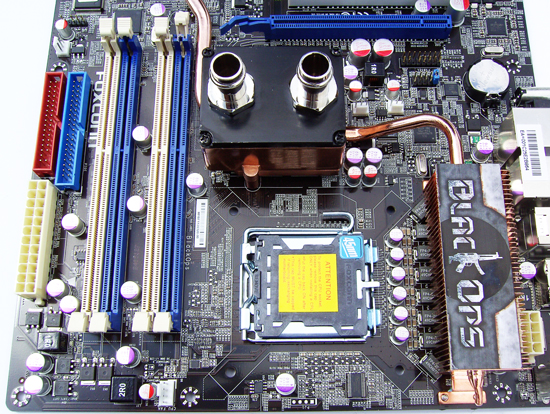 |
You won't find any multiple inductor based illusions to create the impression of more power phases on the Black Ops; what you see is pretty much what you get. Like DFI, Foxconn has opted to employ the use of the Volterra 1115MF PWM controller and accompanying Volterra MOSFETS in an 8-phase delivery configuration to supply processor power. The MOSFETS used here are almost double the size of the ones we are used to seeing on DFI's boards and are a lot more expensive. Foxconn tells us that peak current delivery potential is well in excess of 200A with a voltage rating of 2.5V. Simple math tells us this gives rise to the possibility of supplying 500W peak power, just to the CPU - overkill personified. [Ed: See, there actually is a use for those 1200W PSUs!]
Cooling of the Volterra MOSFETS is very crucial in getting anywhere near this current from them, and thankfully Foxconn uses a bolt-thru heatsink plus a backing plate to ensure that the heatsink remains in contact with all of the MOSFETS even if the socket bows under the pressure of LN2 pots or high torque cooler retention mechanisms. Looking at some of the 6GHz+ speeds that users have obtained using the Black Ops, this particular Volterra solution is certainly no slouch.
The processor socket is reasonably clean and allows for fairly easy insulation for the use of extreme cooling. The EPS12V connector is easy to access at the top left of the socket area. The CPU fan header is placed at the top of the board to the right of the CPU socket, and another five fan headers are placed in key locations on the board. All fan headers are fully speed controllable via the BIOS, providing ample flexibility for keeping the board cool in a variety of situations.
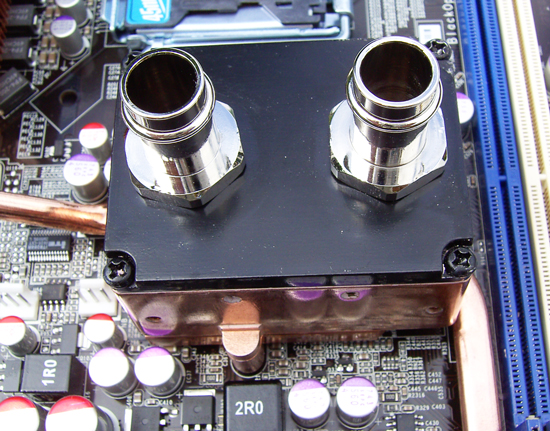 |
ASUS introduced boards with built-in water-cooling options last year. Foxconn continues with this trend but also provides users with a screw down plastic tube for dry ice or LN2 cooling of the Northbridge. (Note that additional motherboard insulation is still required.) The water-cooling top plate is anodized aluminum. Contrary to "popular belief", the chances of galvanic corrosion with this setup are miniscule and there should be no cause for concern. Galvanic corrosion can take years to manifest, and a suitable additive in some distilled de-ionized water should provide ample protection. Both 3/8" and 1/2" barbs are supplied, making it easy to connect the water block into an existing loop.
A small screw-down fan is also provided for users without access to water-cooling, although we feel that water-cooling really is necessary to get the most out of the X48. We ran overclock testing both using both air- and water-cooling and found that FSB scaling and board stability improved noticeably using water. Further, the whole board remains far cooler due to the heatpipe connecting the PWM and Southbridge heatsinks to the Northbridge, making for a more stable system overall - very effective indeed.
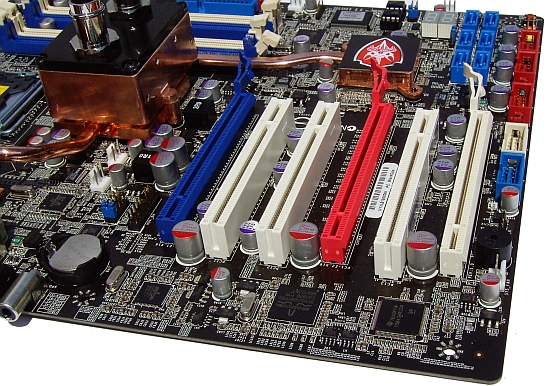 |
Three mechanical x16 length PCI-E slots (2x16 + 1x4 electrical) and three PCI slots make up the expansion of the Black Ops. If using CrossFire with dual-slot GPUs, two of the PCI slots will be inaccessible while the middle PCI slot might just have enough room to house a slim soundcard. Using a long GPU card with a dual-slot cooler will also block three of the SATA ports, although the remaining three should be more than enough for most benchmarking runs.
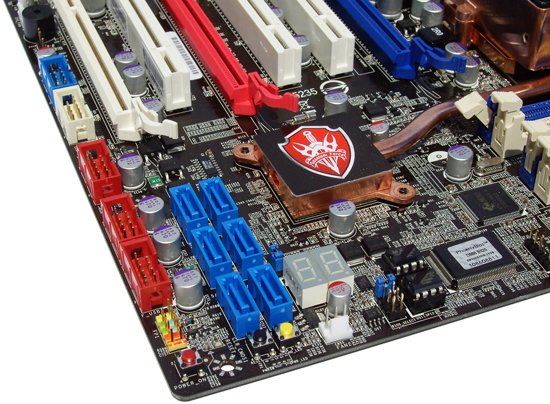 |
Six SATA ports are lined up in banks of three horizontally in the bottom right corner of the board. As we stated above, three will be blocked by the use of a long GPU card in the red PCI-E slot. Power/reset and CMOS clear pushbutton switches are situated at the edge of the board along with a post code display for debugging. A welcome change is the presence of two socket loaded 8-pin EPROMs for BIOS storage. Each chip can store a different BIOS version, which is selectable via an onboard jumper. We quite like the idea of this, as it means you can store your favorite benchmarking and stable BIOS releases and switch between them with a minimal amount of fuss. Three internal USB connectors sit below the SATA ports with the COM and internal 1394 connectors situated underneath the last PCI slot.
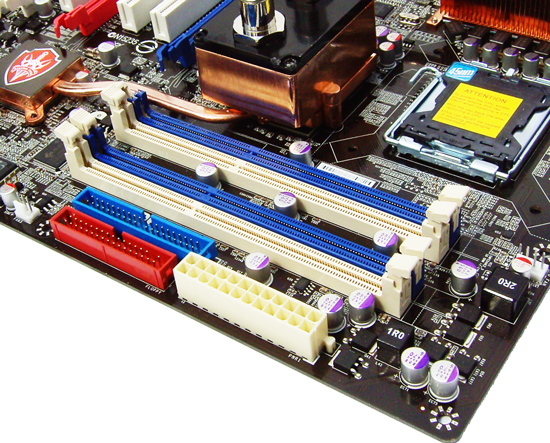 |
The presence of a single inductor on the output side of the VDimm circuit suggests that Foxconn opted for a 2-FET single-phase power solution to provide memory power. Slot placement leaves room to insert longer graphics cards in the primary PEG slot with just enough clearance to use a Corsair Dominator fan to cool memory modules. The ATX 12V connector sits to the right of the memory slots together with the IDE and floppy drive connectors.
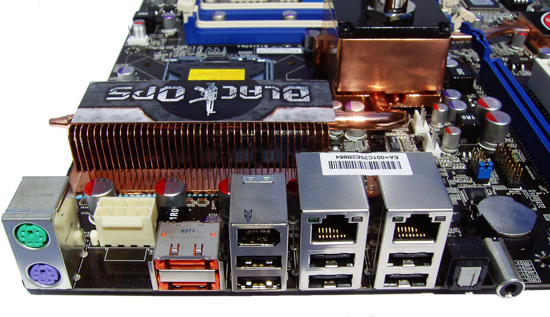 |
The rear I/O panel is home to PS/2 Keyboard and mouse ports, two eSATA connectors, two RJ45 Gigabit Ethernet ports, an IEEE-1394a port, and six USB ports.










32 Comments
View All Comments
ImmortalZ - Thursday, July 31, 2008 - link
You do realize these people are given QX9770s, GTX280s and assorted hardware for free, every generation?Do you know most of these people end up working for the very manufacturer's products they torture test?
Do you know that you're a moron?
strikeback03 - Thursday, July 31, 2008 - link
Personally, I'd rather grow a mullet, buy a Mustang, and head for the local drag strip.Berger - Thursday, July 31, 2008 - link
'Digital Freak' what a freaking handle.No need to be discriminative you narrow minded moron.
Nyarlathotep - Thursday, July 31, 2008 - link
I used to really like linux but the more posts I´ve read by linux users, the more I hate it. Linux nerds probably get paid by Microsoft for ruining linux chances. They are everywhere whining and crying. For every decent linux user there seem to be 5 obnoxious nerds.Yesterday I uninstalled Ubuntu from my laptop because it made me feel like if I supported obnoxious linux nerds. If it wasn´t for them linux would probably be the most popular OS right now, not windows.
TA152H - Thursday, July 31, 2008 - link
One thing I have been saying for 25 years, and has been validated by the years is that Unix will never be a popular operating system. Linux often mentioned by people that don't really use it that much, they want to whine about Microsoft and such, or at a higher level, whine about the establishment in general. Don't get me wrong, I despise Microsoft too, but I'm not so pathetic as to act like Unix is the answer. It's a horrible operating system that's a pain in the backside to work with. They can sugar coat that dung all they want, but it will always smell and will only be a niche product. GUIs help some by insulated the user from the miserable underpinnings, but, really, anyone that likes the word "grep", and thinks upper and lower case parameters should have different meanings, is generally going to be a maladjusted dickhead.I still think OS/2 was better than Windows, but it's very much a niche product now (in its new incarnation as Ecomstation) and is used about as often as rotary telephones. I whined for a while about Windows too, but mainly because all my work experience had been with OS/2, and I didn't want to be jobless :-P.
No one really listens to the whining dorks that cry to the sky about foul play. Linux isn't popular because, basically, it sucks like all Unix varieties do. They'll exist in niches, but you can't expect the mainstream market to embrace it. Apple did a good job of hiding the difficulty of the underlying operating system, but it's still a niche product as well. Even if there were a good operating system it would be extremely difficult to break the software monopoly of Microsoft, so saying a Unix variety would be the dominant operating system were it not for some oft-ignored dweebs, is as silly as the whiners are.
We've already gone from MVS, to DOS, to Windows NT as the dominating operating systems during the lifetime of Unix. It's always been a niche product. Outside of the Microsoft haters, do many people really want it to be anything more than that? It's a pity IBM still won't make OS/2 open source. It would at least have a chance as an open source competitor. Unix? Never. But, as has been the case for 30 years, you'll still hear them saying it's just about to take off. It never changes, and kind of gives one a sense of security in a world that changes too fast. Unix will take over soon! Just wait! It's even money if it will happen before the Sun eats the Earth.
swaaye - Friday, August 1, 2008 - link
:)yyrkoon - Thursday, July 31, 2008 - link
Look. You should be using your OS of choice for YOU, not anyone else.The whole idea is HAVING the ability to make that choice.
I use Windows on my main machines here at home, but I like the option of being able to use which over OS I please on them, and yes, I have a couple of Linux boxen too, as well as an openSolaris machine. Hell, I would not be adverse to putting OSX on my own hardware, IF Steve Jobs and Apple will ever pull its head out of their backsides . . . In a general purpose computer world, proprietary systems are the 'bad guys' not the OS.
yyrkoon - Thursday, July 31, 2008 - link
http://ubuntu-virginia.ubuntuforums.org/showthread...Companies need to learn that business tactics as such will put you into a world of hurt in a hurry. Behold the wonderful internet at its finest.
swaaye - Friday, August 1, 2008 - link
Just how much of an audience in the real world do you think slashdot gets? lol.swaaye - Friday, August 1, 2008 - link
or any site, for that matter.